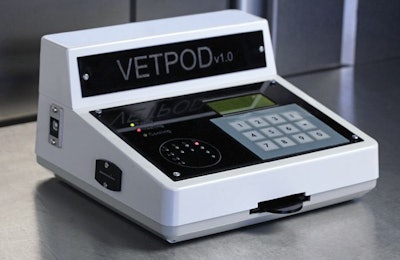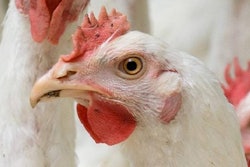
Rapid poultry pathogen detection on-farm or at the processing plant would allow producers and processors to react more quickly where possible threats are suspected but, to date, such technology has only been available in other livestock sectors. This may be about to change.
The first fully operational prototype of VetPod, a lab-on-chip (LOC) prototype system able to rapidly identify several pathogens of concern to the poultry industry, was completed this year and, after promising tests, the technology has now moved to the validation stage.
Developed by the Technical University of Denmark, in collaboration with partners in Germany, Italy, France and Sweden under the European Union-funded Vivaldi project, the VetPod platform should enable the industry to respond more rapidly to a variety of possible threats.
Validation is concentrating on three important zoonotic pathogens: avian influenza virus, Salmonella and Campylobacter, although the disposable plastic cartridges used in VetPod can be adapted to an infinite number of assays for almost all pathogens.
For highly pathogenic avian influenza, validation includes H5 and H7, while for Salmonella the identification of the most important serovars, S. enteritidis, S. typhimurium and S. dublin, are being validated, and for Campylobacter, C. jejuni and C. coli are being looked at.
The formal validation is needed to gain international recognition as an alternative diagnostic test and, once complete, the system could be made available for use by farmers, veterinarians, slaughterhouses and meat and food processing plants. This is expected to happen in 2020.
Spreading benefits to the poultry
The VetPod platform follows the point of care concept of taking the laboratory to the patient. For example, in human medicine, where the concept is well advanced, a doctor runs a blood test in the clinic to guide diagnosis directly from the test results obtained.
Similar approaches, known as pen-side or on-site testing, have been underway in the livestock sector for some time but, to date, a useful and affordable test kit has not been available in the poultry industry.
Manageable scale, operation
Confirming diseases such as avian influenza on-farm, for example, or preventing the release of a batch of Salmonella-contaminated nuggets from the slaughterhouse could transform current disease management.
The challenge for making this a reality has been the expensive and space-consuming analytical equipment operated by specialized technical staff at central laboratories. However, researchers have been able to down-scale the analytical operations to miniature size and simplify their operation so that all the steps in a laboratory analysis can be performed in a small plastic chip measuring less than 5 by 5 centimeters.
After loading the samples, the chip is inserted into a portable instrument that takes the sample through all the analytical steps to final result and readout. Results can be transmitted to a central database, or sent to a PC or cellphone.
Employment of technology
When it comes to disease diagnosis or detection of microbial causes of food-borne disease, little seems to have changed.
Molecular methods such as PCR have made disease diagnosis and detection faster at the laboratory, but the time from sampling to analysis result is still counted in days. The VetPod platform is expected to give results in 30-60 minutes.
Faster results would enable quicker reactions, troubleshooting and problem solving, be it for disease outbreak at the farm or unwanted bacteria in the food production line.
The development of VetPod can be seen as part of a broader change occurring in the poultry industry. The sector is already seeing increasing digitalization and automation in poultry farming and at the processing plant. “Big data” are analyzed and used to optimize production, robots are already at work in cutting and packaging operations at the processing plant, and robots tending chicken are just around the corner.
Workshop
New tools for handling animal health and food safety, the Vivaldi project, is an open workshop that will take place in Parma, Italy, on January 23, 2019, and will feature the VetPod system.
For more information, visit
How Thailand is fighting poultry disease with technology

















